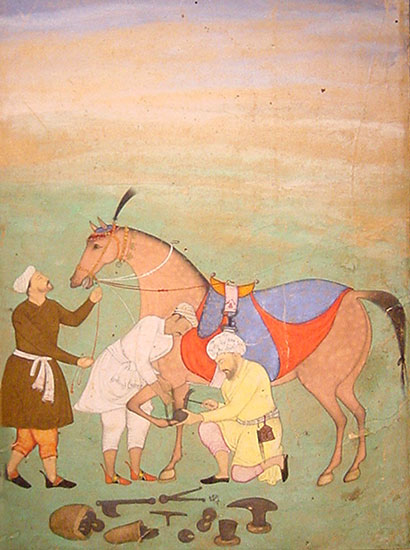
A Scene of Men Shoeing a Horse
Mughal, c. 1605-15
Attributed to Salim Quli
Opaque watercolour and gold and on paper, page
450 x 310 mm; miniature 193 x 140 mm, with a gold-flecked blue border framed
by thin bands of orange, blue and gold, on a pinkish buff-coloured album page
also flecked with gold, the reverse with a Persian calligraphic inscription on
marbled paper by 'Abd al-Rahim 'Ambarin Qalam.
This exquisite painting of three men shoeing a horse is by Salim Quli, an
artist who worked first in Salim's studio in Allahabad and later in the
imperial workshop after Jahangir's accession. The figures bear all the
hallmarks of Salim Quli's mature style. All three have Salim Quli's
characteristically broad-even slightly diminutive-bodies, minimal modelling,
crisp profiles, and lightly drawn facial features. The artists most accessible
works are ff. 338b and 363a in the 1604-10/11 BL Anwar-i Suhayli, which was
started at Allahabad and completed in the imperial workshop (all of the
illustrations are published in Wilkinson, The Lights of Canopus, London,
1929). Each of Salim Quli's illustrations that feature a horse
almost exactly matches the horse being shoed. Salim Quli's faces and modelling
in the present painting (especially of the lower garments on the three
figures) compare very closely to those features in the latter Anwar-i Suhayli
illustration as well as in his signed painting, The Funeral of Alexander (BM
1937 7-10-330, pub. J.M. Rogers, Mughal Miniatures, pl. 54), and his signed
border figures in the Gulshan Album (Nelson-Atkins Museum of Art, Kansas City
68.12/1, published by Milo Beach in The Grand Mogul (p. 49, no. 7 verso, the
woman and man carrying pots on their heads). He has another signed painting
(f. 43a) in a Nal wa Daman manuscript published in Pakistan Archaeology 1972
and now rumored to be in a London private collection.
Salim must have painted this horse-shoeing scene sometime between 1605 and
1615. He superbly renders a relatively unusual subject with elegant
draughtsmanship and subtle coloration. Note the fine details present in the
depiction of the men's turbans and clothing, the still-life quality of the
horse-shoeing tools and the expressive quality in the features of the
attendants absorbed in their work. These details have been laid against a
subtle green ground, which fades into a contourless horizon merging against a
blue sky.
Salim Quli appears to have based this work on drawing attributed to the artist
Ikhlas, who worked in the ateliers of both Akbar and Jahangir. Whereas Salim
Quli adopted a vertical format for this horseshoeing scene, lending it a
greater sense of space, Ikhlas originally compacted this scene within a tight
horizontal compositional field. Salim Quli has eliminated a number of elements
present in the drawing. He omits, for example, the bundled cloth in the lower
left corner of the drawing. This pattern of editing continues in the
elimination of the reins-holder's plume, whip, and knife, the yaktail hanging
from the horse's neck, and the steed's genitals. The rope used to hold up the
leg being shoed is also greatly simplified. On
the other hand, Salim Quli has made minor elaboration's in the painting,
notably in the horse's trappings.
John Seyller attributes the drawing of the horse-shoeing scene to Ikhlas on
the basis of the idiosyncratic faces of the two central. Ikhlas was not a
prolific painter. He worked on animals (in the V&A Baburnama), birds (in the
Gulshan Album and a Musee Guimet painting), and border decorations (in the
1595 Baharistan and Gulshan Album). The key to the present attribution is his
work in the Victoria & Albert Akbarnama (nos. 23 and 60, reproduced
respectively in Stronge 2002, p. 9 and Sen 1984, pl. 46). Note in particular
the chipmunk-like face of the standard-bearer in the right center and the
central figure in the drawing, and the very pointy noses of figures seen in
profile in all three works. Ikhlas was active from ca. 1586 through at least
1610. Ikhlas would have been most likely to have produced this drawing in ca.
1600-05.
The calligraphy on the reverse of the sheet is by 'Abd al-Rahim 'Ambarin Qalam,
one of the foremost Mughal calligraphers. He is shown in the colophon portrait
(dated January 1610) of the British Library Khamsa of Nizami (BL Or. 12208, f.
325b; see J. Losty, The Art of the Book in India, pl. XXI).
We are grateful to John Seyller for his work in helping with the attribution
of this painting. |
![]()